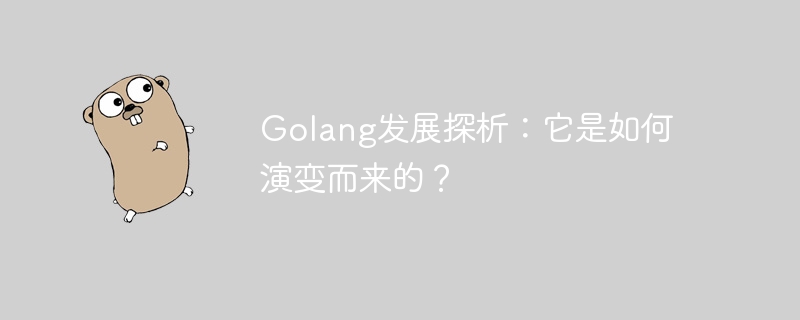

Title: Analysis of Golang Development: How did it evolve?
In recent years, Golang, as an emerging programming language, has attracted much attention in the field of software development. Its simplicity, efficiency, and ease of reading and writing attract more and more developers. So, how did Golang evolve? This article will analyze the development history of Golang, focusing on the important milestones in its evolution, and combine it with specific code examples to lead readers to understand the development trajectory of Golang.
Golang (also known as Go language) is an open source programming language developed by Google and originated in 2007. The original intention of designing Golang was to overcome the bottlenecks of some traditional programming languages, such as the slow running speed of Python and the high complexity of C. Golang is designed as a statically typed, concurrency-safe, and garbage-collected programming language to improve programmer productivity and code quality.
The first stable version of Golang is Go 1.0, released in March 2012. In this version, Golang introduces some important features, including garbage collection, Goroutine concurrency model, interface mechanism, etc. These features give Golang unique advantages in writing efficient concurrent programs.
The following is a simple Go program example, showing the basic usage of Goroutine:
package main import "fmt" func sayHello() { fmt.Println("Hello, Golang!") } func main() { go sayHello() fmt.Println("Main function") }
Go Modules is a major aspect of Golang package management Improvements and officially became a standard feature of the Go language in 2019. Go Modules solves the problem of Golang package dependency management, making it easier for developers to manage project dependencies and introduce third-party packages into the code.
The following is an example of using Go Modules:
$ go mod init example.com/hello $ go get example.com/greetings
As Golang continues to develop, its ecosystem has gradually improved. Now, Golang has a rich set of standard libraries and third-party libraries that can support the development needs of various application scenarios. In addition, Golang also has an active community and excellent open source projects, providing developers with rich learning resources and support.
As a young and dynamic programming language, Golang has broad development prospects in the future. With the rapid development of cloud native, big data, artificial intelligence and other fields, Golang will continue to leverage its advantages in efficient concurrent programming and become one of the first choices for developers.
Summary: Golang, as a modern programming language, has gradually become one of the most popular programming languages in the industry after years of development and improvement. Its design concept and features make it excellent in dealing with various complex engineering problems. With the continuous advancement of technology and the continuous evolution of application scenarios, I believe that Golang will continue to maintain its vitality and bring more innovation and development to the field of software development.
Through the above discussion of Golang’s development history and display of code examples, I believe readers will have a deeper understanding of Golang’s development trajectory and characteristics. I hope Golang can continue to flourish in the future and bring value and innovation to more developers and application scenarios.
The above is the detailed content of Analysis of Golang development: How did it evolve?. For more information, please follow other related articles on the PHP Chinese website!
 Usage of Type keyword in Go
Usage of Type keyword in Go How to implement linked list in go
How to implement linked list in go What are the Go language programming software?
What are the Go language programming software? How to learn go language from 0 basics
How to learn go language from 0 basics How to define variables in golang
How to define variables in golang What are the methods to implement operator overloading in Go language?
What are the methods to implement operator overloading in Go language? What are the operators in Go language?
What are the operators in Go language? What are the data conversion methods in golang?
What are the data conversion methods in golang?



